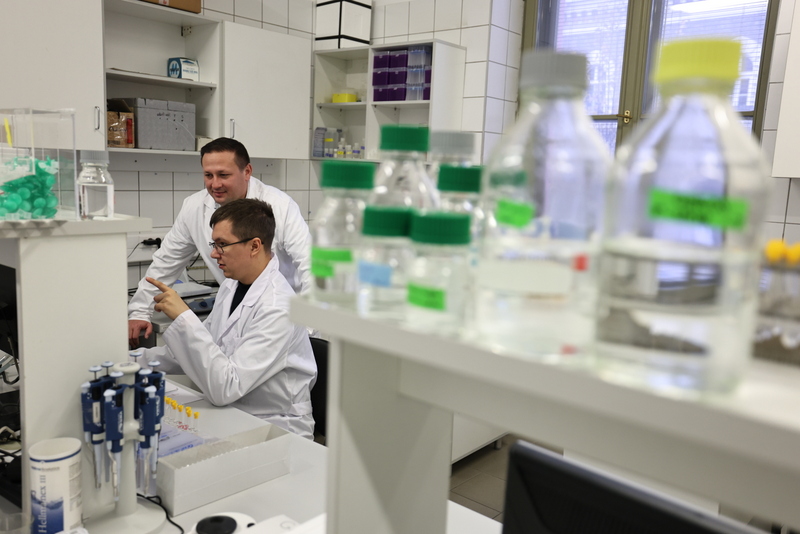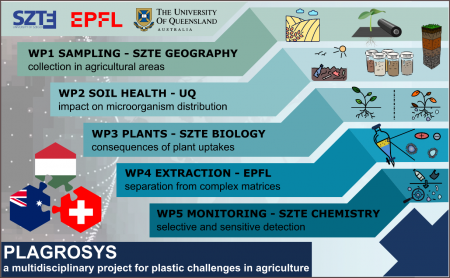
With plastic pollution extending beyond oceans and penetrating our soils, researchers at the University of Szeged are working with international partners to develop innovative methods for detecting and monitoring microplastics and nanoplastics in soil, as well as for removing them from contaminated areas. Their efforts aim to address a pressing environmental challenge that threatens agriculture, ecosystems, and food safety.
“By 2050, there will be more plastic in the oceans than fish.”
While much attention has been given to plastic pollution in our waters, an equally alarming crisis is unfolding beneath our feet: soil contamination. The global surge in plastic pollution poses growing risks, particularly to agricultural productivity and food safety.
Microplastics, and their even smaller counterparts, nanoplastics, are far more insidious than visible plastic waste. Microplastics have already been detected in unexpected places, from the peaks of the Himalayas to the placentas of pregnant women. However, far less is known about the presence and effects of nanoplastics, particularly in soil.
To address this significant research gap, researchers at the University of Szeged, in collaboration with international partners, are conducting groundbreaking interdisciplinary studies. By focusing on the detection, impact, monitoring, and removal of nanoplastics, their work promises crucial advancements in understanding and mitigating this emerging environmental threat.
“When plastic pollution is introduced into the natural environment, it begins to break down due to various mechanical forces – such as wind, temperature changes, and ocean waves,” explains Dr. István Szilágyi, Associate Professor at the University of Szeged’s Department of Physical Chemistry and Materials Science. “It splits into smaller and smaller pieces, eventually becoming microplastics and nanoplastics.”
Dr. Szilágyi, a researcher at the Centre of Excellence for Interdisciplinary Research, Development and Innovation (IKIKK) at the University of Szeged, illustrates the scale of these particles by pointing out that microplastics measure approximately 1 micrometer, equivalent to one-millionth (10⁻⁶) of a meter, or one-thousandth of a millimeter. Nanoplastics are even smaller, with a nanometer being just one-thousandth of a micrometer. These tiny particles pose significant challenges for ecosystems due to their rapid dispersion and accumulation.
The global rise in plastic pollution is causing growing concern, particularly regarding agricultural productivity and food safety – key aspects under investigation by the University of Szeged and its project partners. Sources of soil contamination include sewage sludge compost, untreated wastewater, and plastic films used in agriculture.
As a result of climate change, increasingly frequent droughts lead to soils drying out and cracking, allowing micro- and nanoplastic particles to penetrate deeper and spread more easily. This alters the soil’s nutrient content, chemical composition, and structure, ultimately impacting crop quality and yields.

“We have extensive knowledge about microplastics: we know where they are found and in what amounts,” explains Dr. István Szilágyi. “They have been detected in the snow on the peaks of the Himalayas, in Antarctic penguins, and even in human tissues, such as the placenta. However, when it comes to nanoplastics, we still lack clear information. We don’t yet fully understand how they migrate or what impact they have on living organisms and ecosystems. Because so little is known, we must address the issue through an interdisciplinary approach, drawing on multiple fields of science. That is why the University of Szeged has launched one of Hungary’s first nanoplastic incubation projects, supported by a network of international researchers” says Dr. Szilágyi.
On the one hand, researchers at the SZTE Centre of Excellence for Interdisciplinary Research, Development and Innovation – including physicians, pharmacists, biologists, analysts, physicists, and legal experts – are conducting physiological studies under the professional leadership of Dr. József Maléth. Meanwhile, Dr. István Szilágyi and his team are addressing the issue of agricultural contamination as part of the PLAGROSYS project. This initiative is undertaken in partnership with two internationally renowned partner institutions: the University of Queensland (UQ) in Australia and the École Polytechnique Fédérale de Lausanne (EPFL) in Switzerland, both of which have extensive experience in this field of research.

The institutions involved in the research project are engaged in ongoing collaboration, with their workflows interconnected and building on each other:
Under the leadership of Dr. György Sipos, the Institute of Geography and Earth Sciences at SZTE in conducting field and laboratory studies to investigate the pathways, distribution, and behavior of nanoplastics in agricultural soils treated with municipal sewage sludge.
At the University of Queensland in Australia, researchers are analyzing the effects of nanoplastic contamination on soil health, focusing on changes in soil structure and the distribution of microorganisms.
Coordinated by Dr. Zsuzsanna Kolbert, the Institute of Biology at SZTE is exploring the impact of plastic pollution on the rhizosphere-crop-animal ecosystem.
At the same time, researchers at the École Polytechnique Fédérale de Lausanne in Switzerland are developing innovative compounds known as ionic liquids to enable the selective extraction of nanoplastic particles from water and soil samples – a critical step for determining their quantities.
Supporting all four research units, chemists at the University of Szeged play a central role in the project by analyzing the shape, size, and quantity of nanoplastics. Their research also focuses on the colloid-chemical properties of nanoplastics, including transport, migration, and accumulation, providing essential insights for the ongoing experiments.
The PLAGROSYS project addresses urgent challenges related to plastic pollution in agriculture. Its unique insights into the detection, impact, removal, and chemical characterization of plastic particle contaminants represent an agricultural innovation that is expected to significantly contribute to food safety and the development of related economic sectors.
Original Hungarian text and photos by Anna Bobkó – IKIKK-info

